Lancia Delta 2011 Owner handbook (in English)
Manufacturer: LANCIA, Model Year: 2011, Model line: Delta, Model: Lancia Delta 2011Pages: 290, PDF Size: 8.36 MB
Page 111 of 290

110KNOWING YOUR CAR
fig. 71L0E1009g
fig. 72L0E1010g
123
Page 112 of 290

–
Driving Advisor on
–
–
Driving Advisor on
Driving Advisor off
Driving Advisor off
Keep your hands
on the steering wheel
Driving Advisor
not available
see Handbook
Driving Advisor offSystem not activated
The system has been
engaged
and it is not activated
The system is searching
for the operating conditions
The system is activated and
the operating conditions
have been recognised
The system has been
engaged and is immediately
activated
The system has been
turned off manually
The system has been
turned off automatically
The system warns
the driver to place his/her
hands on the steering wheel
The system is faulty:
go to a Lancia Dealership
The system was not engaged
due to the activation
of sports driving mode
1
KNOWING YOUR CAR111
TABLE SUMMARIZING SIGNALS DURING THE USE OF THE DRIVING ADVISOR
–
–
–
–
–
–
3 signals
Single prolonged
warning
Single warning
3 signals–
eflashing
eflashing
–
–
–
–
eConstantly on
e!Constantly on
–
Status of the LED Message on the display Status of icon Acoustic signal Meaning
on the button (fig. 71 and 72) on display
Off
On flashing
On flashing
On constantly
On constantly
Off
Off
On constantly
Off
Off
Page 113 of 290
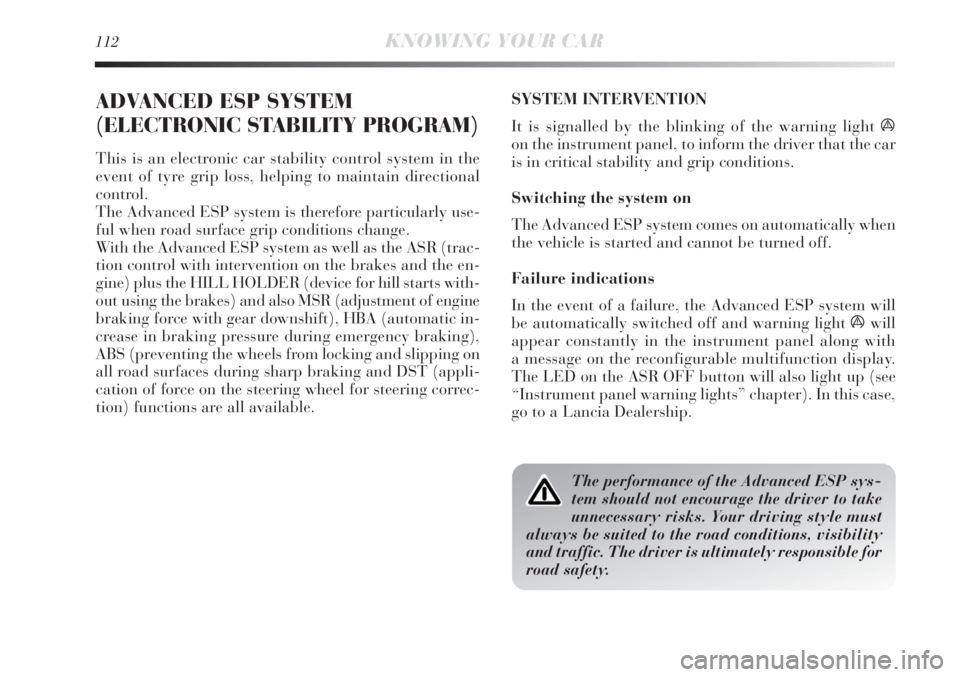
112KNOWING YOUR CAR
ADVANCED ESP SYSTEM
(ELECTRONIC STABILITY PROGRAM)
This is an electronic car stability control system in the
event of tyre grip loss, helping to maintain directional
control.
The Advanced ESP system is therefore particularly use-
ful when road surface grip conditions change.
With the Advanced ESP system as well as the ASR (trac-
tion control with intervention on the brakes and the en-
gine) plus the HILL HOLDER (device for hill starts with-
out using the brakes) and also MSR (adjustment of engine
braking force with gear downshift), HBA (automatic in-
crease in braking pressure during emergency braking),
ABS (preventing the wheels from locking and slipping on
all road surfaces during sharp braking and DST (appli-
cation of force on the steering wheel for steering correc-
tion) functions are all available. SYSTEM INTERVENTION
It is signalled by the blinking of the warning light á
on the instrument panel, to inform the driver that the car
is in critical stability and grip conditions.
Switching the system on
The Advanced ESP system comes on automatically when
the vehicle is started and cannot be turned off.
Failure indications
In the event of a failure, the Advanced ESP system will
be automatically switched off and warning light áwill
appear constantly in the instrument panel along with
a message on the reconfigurable multifunction display.
The LED on the ASR OFF button will also light up (see
“Instrument panel warning lights” chapter). In this case,
go to a Lancia Dealership.
The performance of the Advanced ESP sys-
tem should not encourage the driver to take
unnecessary risks. Your driving style must
always be suited to the road conditions, visibility
and traffic. The driver is ultimately responsible for
road safety.
Page 114 of 290
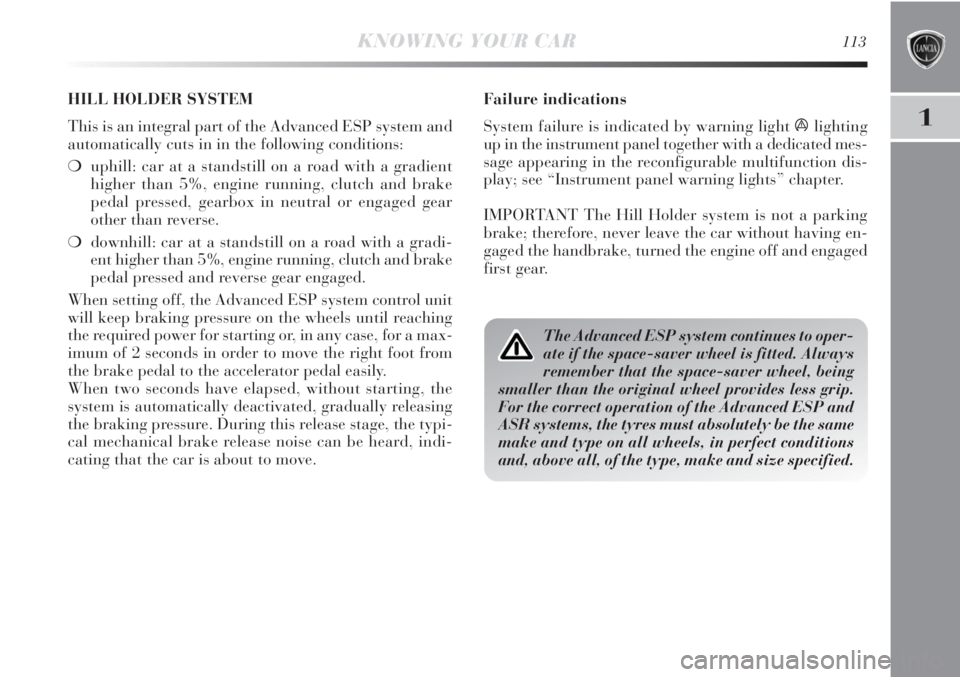
1
KNOWING YOUR CAR113
Failure indications
System failure is indicated by warning light
álighting
up in the instrument panel together with a dedicated mes-
sage appearing in the reconfigurable multifunction dis-
play; see “Instrument panel warning lights” chapter.
IMPORTANT The Hill Holder system is not a parking
brake; therefore, never leave the car without having en-
gaged the handbrake, turned the engine off and engaged
first gear.
The Advanced ESP system continues to oper-
ate if the space-saver wheel is fitted. Always
remember that the space-saver wheel, being
smaller than the original wheel provides less grip.
For the correct operation of the Advanced ESP and
ASR systems, the tyres must absolutely be the same
make and type on all wheels, in perfect conditions
and, above all, of the type, make and size specified.
HILL HOLDER SYSTEM
This is an integral part of the Advanced ESP system and
automatically cuts in in the following conditions:
❍uphill: car at a standstill on a road with a gradient
higher than 5%, engine running, clutch and brake
pedal pressed, gearbox in neutral or engaged gear
other than reverse.
❍downhill: car at a standstill on a road with a gradi-
ent higher than 5%, engine running, clutch and brake
pedal pressed and reverse gear engaged.
When setting off, the Advanced ESP system control unit
will keep braking pressure on the wheels until reaching
the required power for starting or, in any case, for a max-
imum of 2 seconds in order to move the right foot from
the brake pedal to the accelerator pedal easily.
When two seconds have elapsed, without starting, the
system is automatically deactivated, gradually releasing
the braking pressure. During this release stage, the typi-
cal mechanical brake release noise can be heard, indi-
cating that the car is about to move.
Page 115 of 290
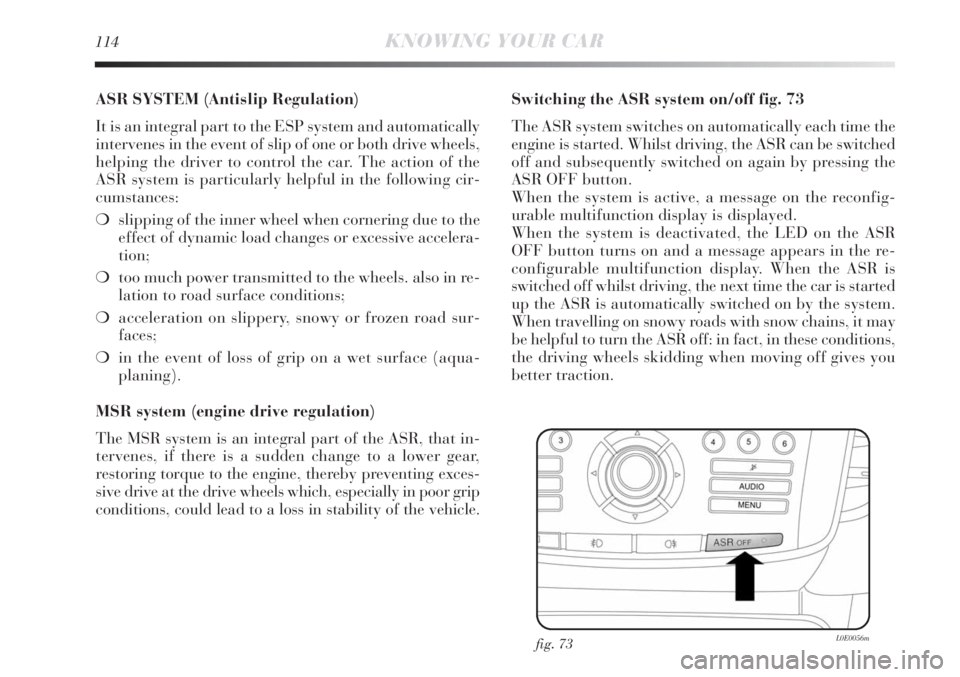
114KNOWING YOUR CAR
ASR SYSTEM (Antislip Regulation)
It is an integral part to the ESP system and automatically
intervenes in the event of slip of one or both drive wheels,
helping the driver to control the car. The action of the
ASR system is particularly helpful in the following cir-
cumstances:
❍slipping of the inner wheel when cornering due to the
effect of dynamic load changes or excessive accelera-
tion;
❍too much power transmitted to the wheels. also in re-
lation to road surface conditions;
❍acceleration on slippery, snowy or frozen road sur-
faces;
❍in the event of loss of grip on a wet surface (aqua-
planing).
MSR system (engine drive regulation)
The MSR system is an integral part of the ASR, that in-
tervenes, if there is a sudden change to a lower gear,
restoring torque to the engine, thereby preventing exces-
sive drive at the drive wheels which, especially in poor grip
conditions, could lead to a loss in stability of the vehicle.Switching the ASR system on/off fig. 73
The ASR system switches on automatically each time the
engine is started. Whilst driving, the ASR can be switched
off and subsequently switched on again by pressing the
ASR OFF button.
When the system is active, a message on the reconfig-
urable multifunction display is displayed.
When the system is deactivated, the LED on the ASR
OFF button turns on and a message appears in the re-
configurable multifunction display. When the ASR is
switched off whilst driving, the next time the car is started
up the ASR is automatically switched on by the system.
When travelling on snowy roads with snow chains, it may
be helpful to turn the ASR off: in fact, in these conditions,
the driving wheels skidding when moving off gives you
better traction.
fig. 73L0E0056m
Page 116 of 290
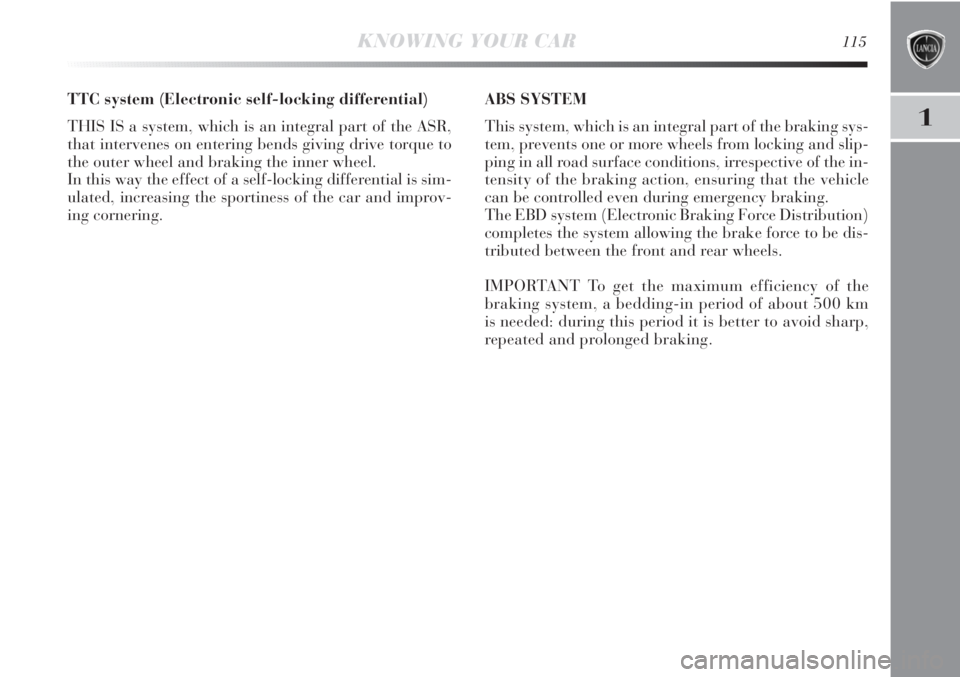
1
KNOWING YOUR CAR115
TTC system (Electronic self-locking differential)
THIS IS a system, which is an integral part of the ASR,
that intervenes on entering bends giving drive torque to
the outer wheel and braking the inner wheel.
In this way the effect of a self-locking differential is sim-
ulated, increasing the sportiness of the car and improv-
ing cornering.ABS SYSTEM
This system, which is an integral part of the braking sys-
tem, prevents one or more wheels from locking and slip-
ping in all road surface conditions, irrespective of the in-
tensity of the braking action, ensuring that the vehicle
can be controlled even during emergency braking.
The EBD system (Electronic Braking Force Distribution)
completes the system allowing the brake force to be dis-
tributed between the front and rear wheels.
IMPORTANT To get the maximum efficiency of the
braking system, a bedding-in period of about 500 km
is needed: during this period it is better to avoid sharp,
repeated and prolonged braking.
Page 117 of 290
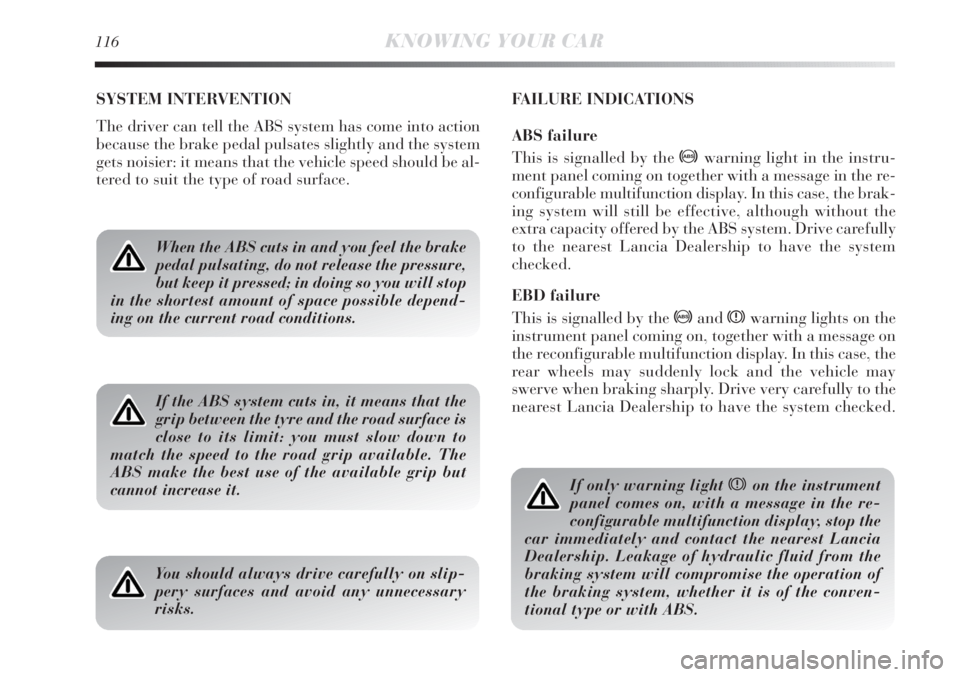
116KNOWING YOUR CAR
SYSTEM INTERVENTION
The driver can tell the ABS system has come into action
because the brake pedal pulsates slightly and the system
gets noisier: it means that the vehicle speed should be al-
tered to suit the type of road surface.FAILURE INDICATIONS
ABS failure
This is signalled by the >warning light in the instru-
ment panel coming on together with a message in the re-
configurable multifunction display. In this case, the brak-
ing system will still be effective, although without the
extra capacity offered by the ABS system. Drive carefully
to the nearest Lancia Dealership to have the system
checked.
EBD failure
This is signalled by the >andxwarning lights on the
instrument panel coming on, together with a message on
the reconfigurable multifunction display. In this case, the
rear wheels may suddenly lock and the vehicle may
swerve when braking sharply. Drive very carefully to the
nearest Lancia Dealership to have the system checked.
When the ABS cuts in and you feel the brake
pedal pulsating, do not release the pressure,
but keep it pressed; in doing so you will stop
in the shortest amount of space possible depend-
ing on the current road conditions.
If the ABS system cuts in, it means that the
grip between the tyre and the road surface is
close to its limit: you must slow down to
match the speed to the road grip available. The
ABS make the best use of the available grip but
cannot increase it.
You should always drive carefully on slip-
pery surfaces and avoid any unnecessary
risks.
If only warning light xon the instrument
panel comes on, with a message in the re-
configurable multifunction display, stop the
car immediately and contact the nearest Lancia
Dealership. Leakage of hydraulic fluid from the
braking system will compromise the operation of
the braking system, whether it is of the conven-
tional type or with ABS.
Page 118 of 290
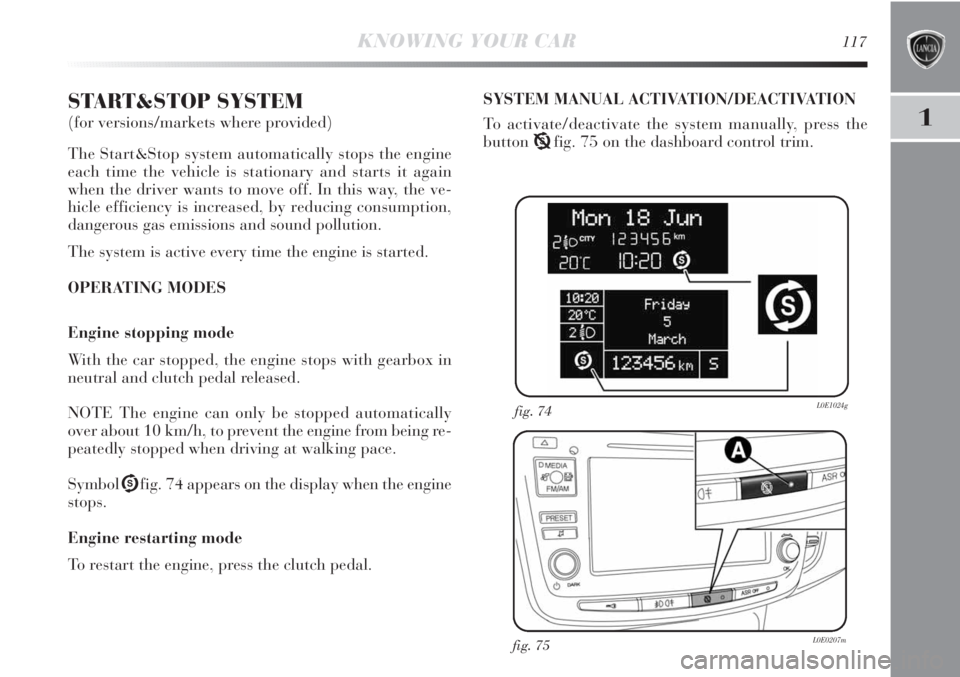
1
KNOWING YOUR CAR117
START&STOP SYSTEM
(for versions/markets where provided)
The Start&Stop system automatically stops the engine
each time the vehicle is stationary and starts it again
when the driver wants to move off. In this way, the ve-
hicle efficiency is increased, by reducing consumption,
dangerous gas emissions and sound pollution.
The system is active every time the engine is started.
OPERATING MODES
Engine stopping mode
With the car stopped, the engine stops with gearbox in
neutral and clutch pedal released.
NOTE The engine can only be stopped automatically
over about 10 km/h, to prevent the engine from being re-
peatedly stopped when driving at walking pace.
SymbolUfig. 74 appears on the display when the engine
stops.
Engine restarting mode
To restart the engine, press the clutch pedal.SYSTEM MANUAL ACTIVATION/DEACTIVATION
To activate/deactivate the system manually, press the
buttonTfig. 75 on the dashboard control trim.
fig. 74L0E1024g
fig. 75L0E0207m
Page 119 of 290
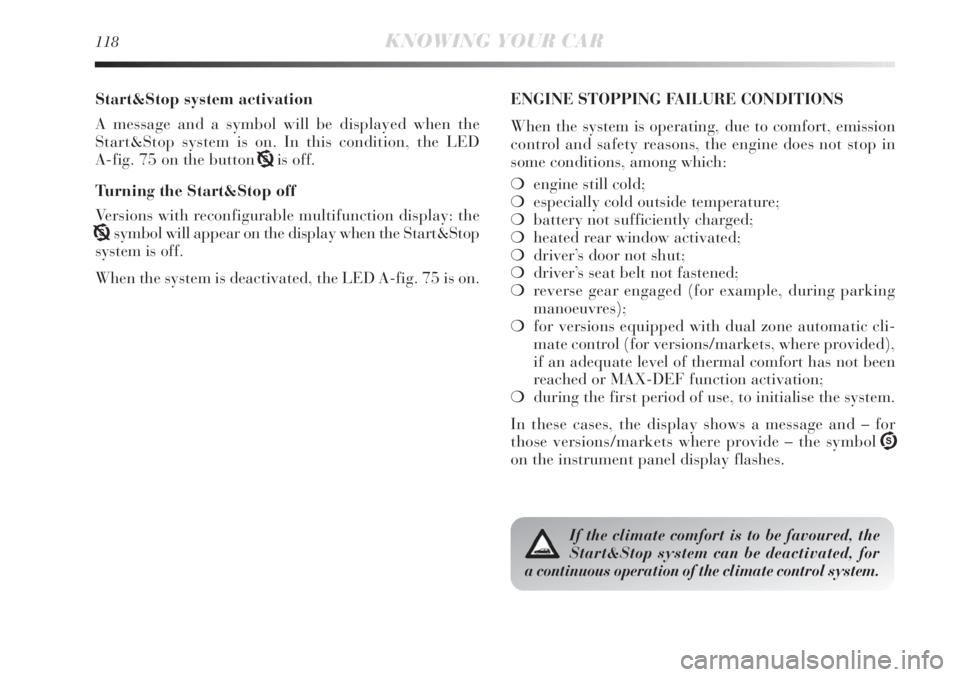
118KNOWING YOUR CAR
Start&Stop system activation
A message and a symbol will be displayed when the
Start&Stop system is on. In this condition, the LED
A-fig. 75 on the button Tis off.
Turning the Start&Stop off
Versions with reconfigurable multifunction display: the
Tsymbol will appear on the display when the Start&Stop
system is off.
When the system is deactivated, the LED A-fig. 75 is on.ENGINE STOPPING FAILURE CONDITIONS
When the system is operating, due to comfort, emission
control and safety reasons, the engine does not stop in
some conditions, among which:
❍engine still cold;
❍especially cold outside temperature;
❍battery not sufficiently charged;
❍heated rear window activated;
❍driver’s door not shut;
❍driver’s seat belt not fastened;
❍reverse gear engaged (for example, during parking
manoeuvres);
❍for versions equipped with dual zone automatic cli-
mate control (for versions/markets, where provided),
if an adequate level of thermal comfort has not been
reached or MAX-DEF function activation;
❍during the first period of use, to initialise the system.
In these cases, the display shows a message and – for
those versions/markets where provide – the symbol U
on the instrument panel display flashes.
If the climate comfort is to be favoured, the
Start&Stop system can be deactivated, for
a continuous operation of the climate control system.
Page 120 of 290
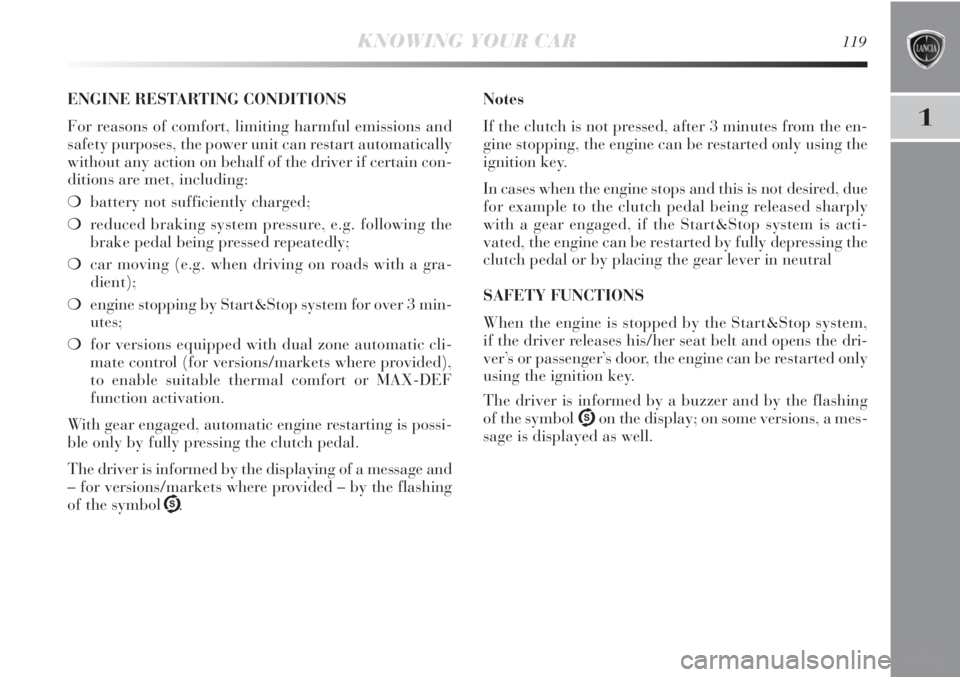
1
KNOWING YOUR CAR119
ENGINE RESTARTING CONDITIONS
For reasons of comfort, limiting harmful emissions and
safety purposes, the power unit can restart automatically
without any action on behalf of the driver if certain con-
ditions are met, including:
❍battery not sufficiently charged;
❍reduced braking system pressure, e.g. following the
brake pedal being pressed repeatedly;
❍car moving (e.g. when driving on roads with a gra-
dient);
❍engine stopping by Start&Stop system for over 3 min-
utes;
❍for versions equipped with dual zone automatic cli-
mate control (for versions/markets where provided),
to enable suitable thermal comfort or MAX-DEF
function activation.
With gear engaged, automatic engine restarting is possi-
ble only by fully pressing the clutch pedal.
The driver is informed by the displaying of a message and
– for versions/markets where provided – by the flashing
of the symbol U.Notes
If the clutch is not pressed, after 3 minutes from the en-
gine stopping, the engine can be restarted only using the
ignition key.
In cases when the engine stops and this is not desired, due
for example to the clutch pedal being released sharply
with a gear engaged, if the Start&Stop system is acti-
vated, the engine can be restarted by fully depressing the
clutch pedal or by placing the gear lever in neutral
SAFETY FUNCTIONS
When the engine is stopped by the Start&Stop system,
if the driver releases his/her seat belt and opens the dri-
ver’s or passenger’s door, the engine can be restarted only
using the ignition key.
The driver is informed by a buzzer and by the flashing
of the symbol Uon the display; on some versions, a mes-
sage is displayed as well.